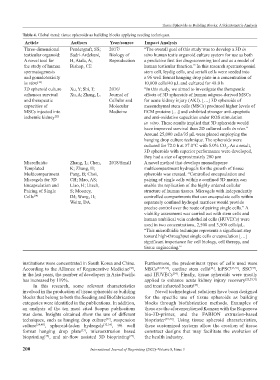Page 208 - IJB-8-3
P. 208
Tissue Spheroids as Building Blocks: A Scientometric Analysis
Table 4. Global trend: tissue spheroids as building blocks applying seeding techniques.
Article Authors Year/source Impact Analysis
Three-dimensional Pendergraft, SS; 2017/ “The overall goal of this study was to develop a 3D in
testicular organoid: Sadri-Ardekani, Biology of vitro human testis organoid culture system for use as both
A novel tool for H, Atala, A; Reproduction a predictive first tier drug-screening tool and as a model of
the study of human Bishop, CE human testicular function.” In this research spermatogonial
spermatogenesis stem cell, leydig cells, and sertoli cells were seeded into
and gonadotoxicity a 96 well format hanging drop plate in a concentration of
in vitro [33] 10,000 cells/40 µL and cultured for 48.0 h
3D spheroid culture Xu, Y; Shi, T; 2016/ “In this study, we aimed to investigate the therapeutic
enhances survival Xu, A; Zhang, L. Journal of effects of 3D spheroids of human adipose‐derived MSCs
and therapeutic Cellular and for acute kidney injury (AKI). […] 3D spheroids of
capacities of Molecular mesenchymal stem cells (MSCs) produced higher levels of
MSCs injected into Medicine ECM proteins […] and exhibited stronger anti-apoptotic
ischemic kidney [23] and anti-oxidative capacities under ROS stimulation
in vitro. These results implied that 3D spheroids would
have improved survival than 2D cultured cells in vivo.”
Around 25,000 cells/35 µL were placed employing the
hanging drop culture technique. The spheroids were
cultured for 72.0 h at 37.0°C with 5.0% CO . As a result,
2
3D spheroids with superior performance were developed,
they had a size of approximately 200 µm
Microfluidic Zhang, L; Chen, 2018/Small A novel method that develops monodisperse
Templated K; Zhang, H; multicompartment hydrogels for the growth of tissue
Multicompartment Pang, B; Choi, spheroids was created. “Controlled encapsulation and
Microgels for 3D CH; Mao, AS; pairing of single cells within a confined 3D matrix can
Encapsulation and Liao, H; Utech, enable the replication of the highly ordered cellular
Pairing of Single S; Mooney, structure of human tissues. Microgels with independently
Cells [34] DJ; Wang, H; controlled compartments that can encapsulate cells within
Weitz, DA. separately confined hydrogel matrices would provide
precise control over the route of pairing single cells.” A
viability assessment was carried out with stem cells and
human umbilical vein endothelial cells (HUVECs) were
used in two concentrations, 2,500 and 3,500 cells/µL.
“This microfluidic technique represents a significant step
toward high-throughput single cells encapsulation […]
significant importance for cell biology, cell therapy, and
tissue engineering.”
institutions were concentrated in South Korea and China. Furthermore, the predominant types of cells used were
According to the Alliance of Regenerative Medicine , MSCs [22,23,34] , cardiac stem cells , hiPSC [25,31] , SSC ,
[24]
[33]
[38]
in the last years, the number of developers in Asia-Pacific and HUVECs . Finally, tissue spheroids were mostly
[34]
has increased by 119%. applied to enhance acute kidney injury recovery [22,23,31]
In this research, some relevant characteristics and treat infarcted hearts .
[24]
involved in the production of tissue spheroids as building Novel technological solutions have been designed
blocks that belong to both the Seeding and Biofabrication for the specific use of tissue spheroids as building
categories were identified in the publications. In addition, blocks through biofabrication methods. Examples of
an analysis of the ten most cited Scopus publications those are the aforementioned Kenzan with the Regenova
was done. Insights obtained show the use of different bio-3D-printer, and the FABION extrusion-based
techniques, such as hanging drop culture , suspension bioprinter [39,40] . Using tissue spheroid characteristics,
[22]
culture [24,48] , spheroid-laden hydrogels [32,34] , 96 well these customized systems allow the creation of tissue
format hanging drop plate , microextrusion based construct designs that may facilitate the evolution of
[33]
bioprinting , and air-flow assisted 3D bioprinting . the health industry.
[27]
[25]
200 International Journal of Bioprinting (2022)–Volume 8, Issue 3

